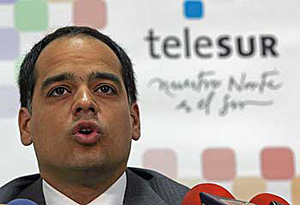 |
 |
 |
 Travel Writers' Resources | January 2007 Travel Writers' Resources | January 2007  
Twenty-Eight Journalists Killed in Eight Latin American Countries in 2006
 Hernán Uribe - International Relations Center (I.R.C.) Hernán Uribe - International Relations Center (I.R.C.)


| At a press conference, Andres Izarra, director of Telesur, protests the arrest of Freddy Muñoz Altamiranda, the television station's correspondent in Bogotá, Colombia.

The Fallen

The following is the list, by country, of fallen journalists of 2006:

ECUADOR: José Luis León, in Guayaquil, reporter at "Radio Minutera," and Saúl Suárez, reporter at La Hora Durandeña. Both were shot.

EL SALVADOR: Douglas Henández of La Prensa Gráfica.

COLOMBIA: Gustavo Rojas Gabalo, radio journalist, shot; Mariano Pérez Murga, and Francisco Bonilla Romero.

GUATEMALA: Edgardo Maas, radio correspondent, received five bullets.

GUYANA: Ronaldo Waddell, TV correspondent, shot; Richard Stewart, Chetram Pergaud, Elión Wegman, Mark Mikoo and Shazim Mohamed. The last five were shot on Aug. 8 inside the office of Kaieteur News.

DOMINICAN REPUBLIC: Domingo Disla Florentino, lawyer and journalist, Facundo Lavatta, of "Radio Comercial."

VENEZUELA: Jesús Flores Rojas, in the town of El Tigre; Jorge Aguirre, of Cadena Carriles, and Pedro Bastardo, killed in Cumaná.

MEXICO: José Valdés, in Sabinas (Coahuila); Jaime Olvera Bravo, in La Piedad (Michoacán); Ramiro Téllez Contreras, in Nuevo Laredo (Tamaulipas); Enrique Perea Quintanilla; Rosendo Pardo Ozuna, in Tuxtla Gutiérrez; Misael Tamayo Hernández, in Zihuatanejo (Guerrero); José Manuel Nava, ex-director of the daily paper Excélsior, in Mexico City; Roberto Marcos García, correspondent of Alarma in Veracruz; Alfonso Sánchez Guzmán; and Bradley Hill, American, in Santa Lucía del Camino (Oaxaca). |
Twenty-eight journalists were murdered, while five others disappeared, last year in eight Latin American countries, according to an overview of 2006 prepared by the Commission to Investigate Attacks Against Journalists (Comisión Investigadora de Atentados a Periodistas, C.I.A.P.), affiliated with the Latin American Federation of Journalists ( Federación Latinoamericana de Periodistas, F.E.L.A.P.). With 10 deaths, Mexico continues to boast the dubious distinction of being the most dangerous nation for journalists to ply their trade.

Although figures on journalists victimized by violence vary, the most credible numbers appear to be those provided by the World Association of Newspapers, which says that 105 journalists were killed worldwide last year. Forty-eight of these deaths occurred in Iraq, a country racked by a bloody war resulting from the United States' illegal armed occupation.

In late December, the United Nations Security Council unanimously approved a resolution that "condemns all attacks against journalists in situations of conflict, and calls upon warring factions to respect communicators and their role." In so doing, however, the United Nations merely recalled that the Geneva Conventions on war classify journalists as civilians whose lives must be respected. In point of fact, journalists' lives are not being respected, as evidenced by the frequent murders of journalists in Iraq at the hands of rogue United States soldiers.

Moreover, the United Nations resolution is completely oblivious to the situation in Latin America. In this region—with or without military conflicts—journalists are gunned down by drug-traffickers and by various mafias—invariably for having witnessed crimes. Journalists were killed during the civil-military dictatorships that gained strength in the 1970's. However, this situation has continued up to this day, despite the return to civilian rule. In August, the Organization of American States' Office of the Special Rapporteur for Freedom of Expression reported that in the last 10 years 83 journalists have been killed in Colombia and 24 in each of Brazil and Mexico. The O.A.S. said that journalists have also been killed in Guatemala, Ecuador, Haiti, Nicaragua, and Venezuela, among other countries.

In November, the widespread insecurity faced by journalists was referred to by CIAP director José Dos Santos, during the Fifth World Meeting of War Correspondents in Havana: "In Latin America journalists are killed, without internal wars or foreign military invasion, other than the low-intensity armed conflict that has rocked Colombia for a half century." Dos Santos also underscored that since 1976 some 800 journalists have been slain in the region.

Justice Delayed

Another proverbial characteristic of the crimes committed against journalists is the pervasive impunity. According to a study by the United States-based Committee to Protect Journalists, between 1992 and 2006, 580 journalists were killed; in 85 percent of the cases, no one was held accountable. Latin American history is littered with such impunity.

However, one important exception has emerged. In Chile, at the very end of 2006, 20 years after José Carrasco Tapia was assassinated, the perpetrators of his murder received sentences of 13 years in prison and other penalties. All of the perpetrators were members of dictator Augusto Pinochet's military police, known as the DINA. Carrasco Tapia, the head of the College of Journalists and the international editor of Análisis magazine, was brutally murdered with 13 gunshots on Sept. 8, 1986. The 14 defendants had killed three other people—none of whom were journalists—in a gangland-style revenge for a failed attempt on the tyrant's life the day before Carrasco Tapia's murder. In addition, the government was ordered to pay 2.125 million pesos ($3,921) to the victims' widows, children, and other survivors.

Moreover, 2006 was also notable for various types of attacks intended to limit freedom of expression and intimidate journalists. The most recent of these was the arrest in Bogotá of Freddy Muñoz Altamiranda, correspondent for Telesur, a television channel with a presence in several countries. Following his Nov. 20 arrest, Muñoz was charged with "insurrection and terrorism." Muñoz as well as Telesur and F.E.L.A.P. called the police action a violation of freedom of speech and an attempt to intimidate the independent journalism practiced by Telesur. [Muñoz was released from jail on Jan. 9.]

Chilean journalist Hernán Uribe is president of F.E.L.A.P.'s Commission to Investigate Attacks against Journalists (C.I.A.P.). Translated for the IRC Americas Program by Alan Hynds. | 
 | |
 |



